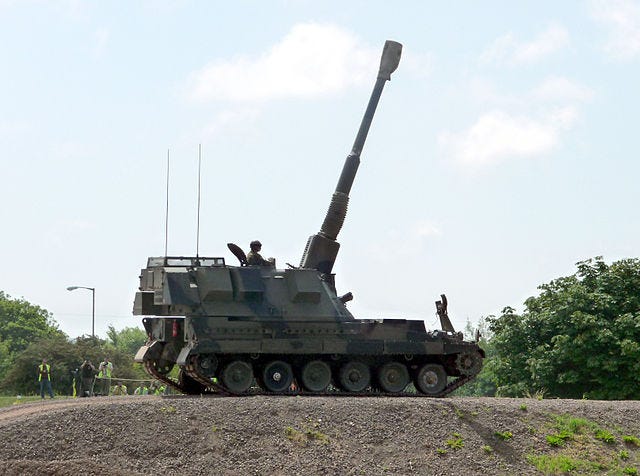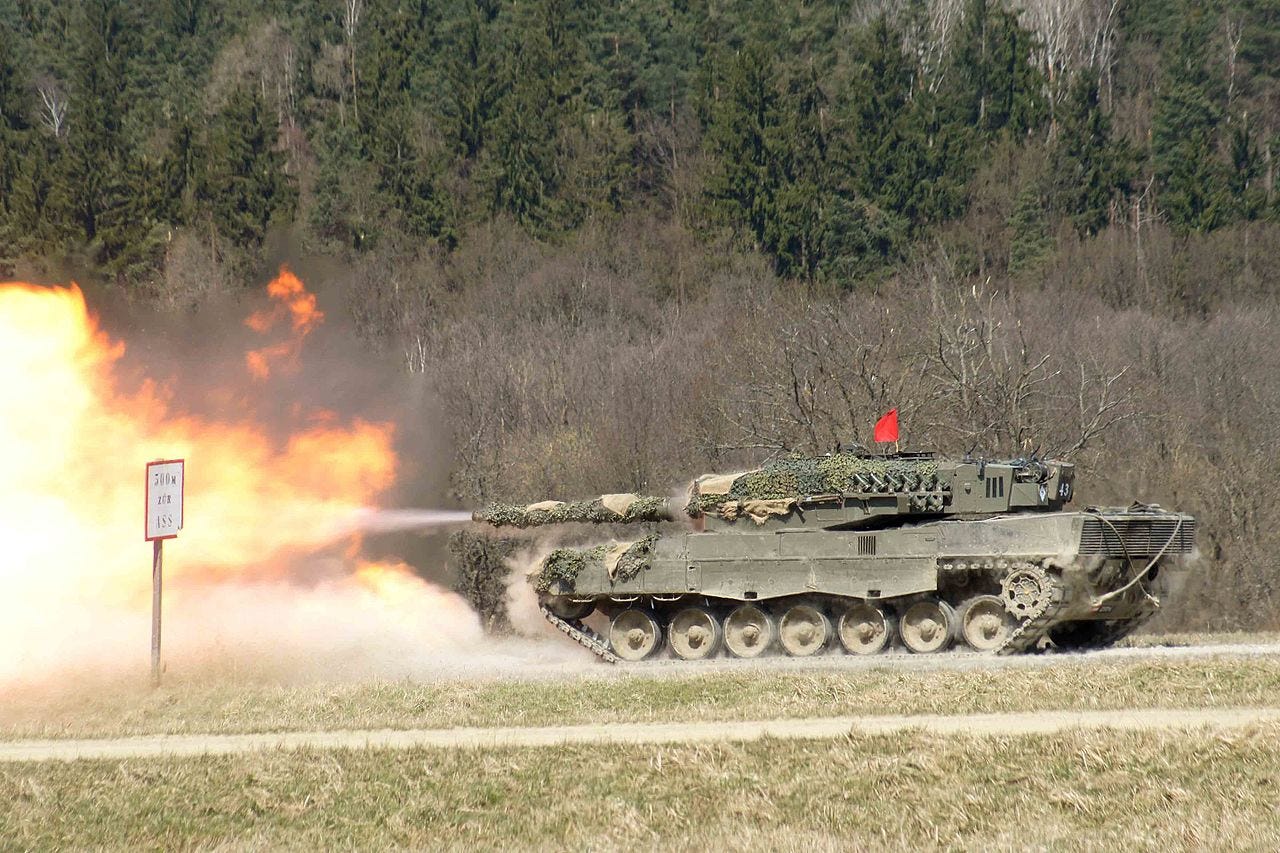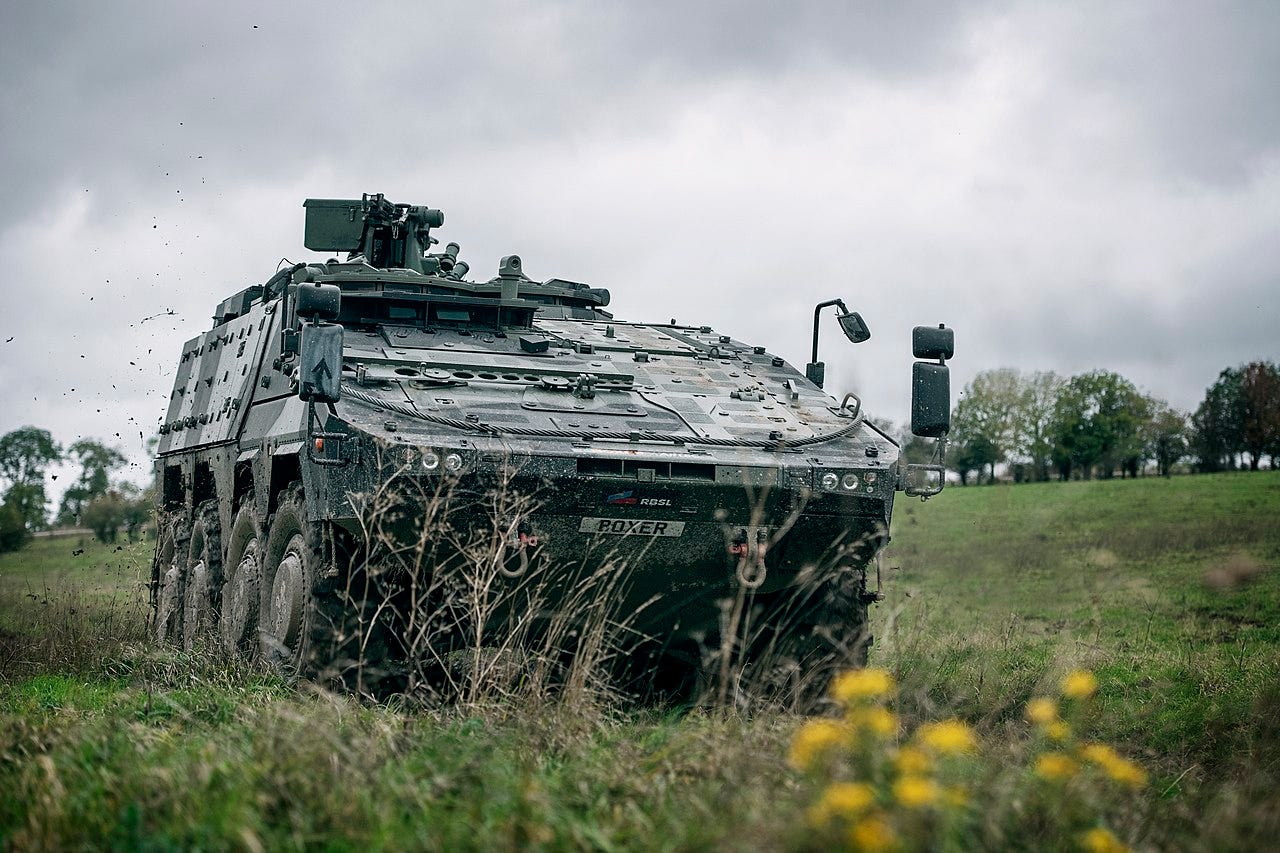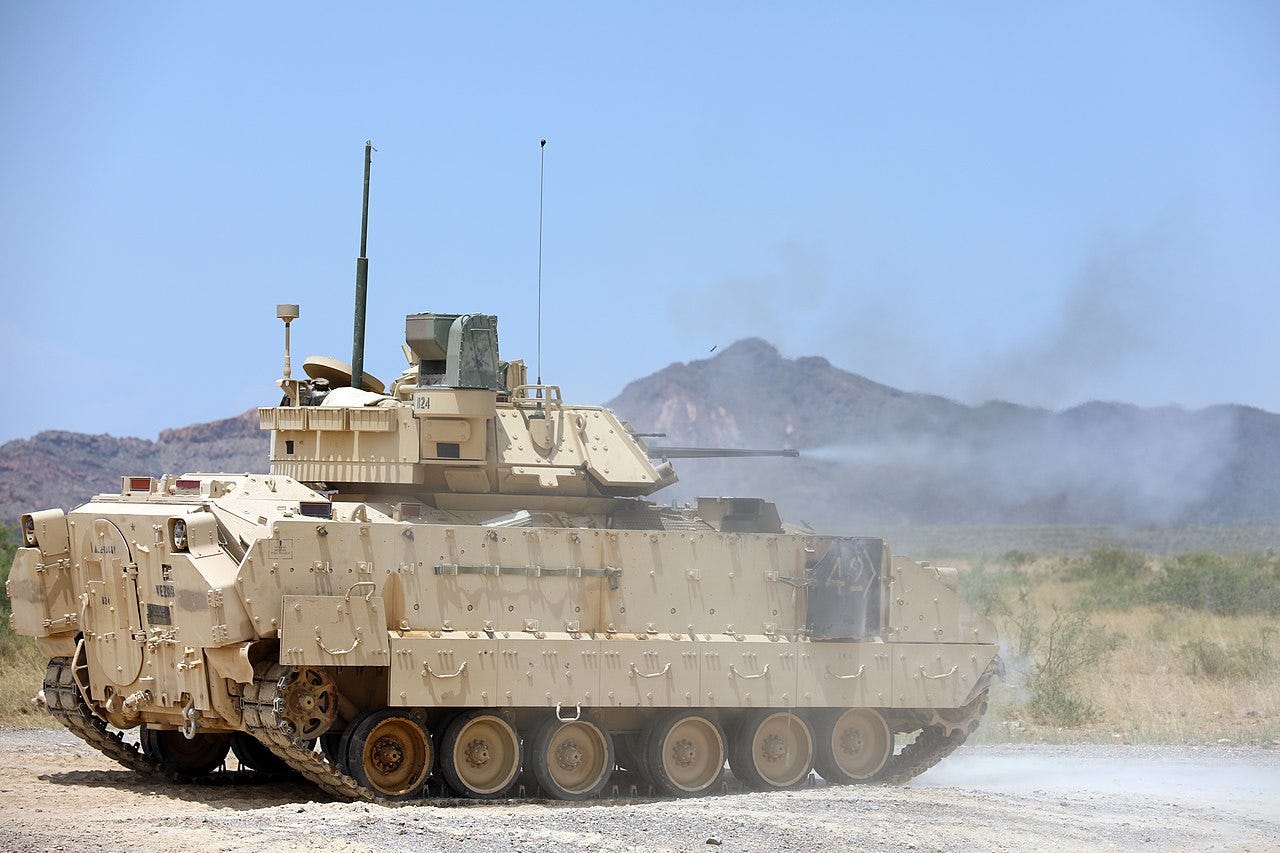When is a Tank not a Tank?
On the military menagerie of armoured vehicles
Here’s a fun question for you – which of the below images is a tank?
And the answer is….
…….
……..
………
None of them!
They are, starting from the top left in clockwise order:
1) An armoured personnel carrier
2) An infantry fighting vehicle
3) A self-propelled artillery gun
4) A reconnaissance vehicle
Though superficially similar, all have quite different roles on the battlefield.
Hence, consider this a short spotter’s guide to the most common armoured fighting vehicles (‘AFVs’, donchaknow) in modern armies. By the end of this, you should hopefully have enough information to listen to (often dull) defence analysts without needing to constantly google acronyms.
Main Battle Tank (MBT)
This is a tank:
Tanks are traditionally the apex predators of the ground vehicle food chain, offering the best possible balance of the holy trinity between mobility, firepower, and protection. In simple terms they are supposed to be able to get anywhere (tracks), blow up anything (big gun) and shrug off all but the biggest hits (strong armour).
Tanks are defined by their role for frontline shock action – in simple terms, they are offensive tools for breaking open an enemy front line. During an assault, the tanks lead the way for other elements. In many ways, they are the direct descendent of the old heavy cavalryman or knight, using speed and shock to smash through the enemy.
How can you tell a tank from a not-tank? In general, consider the following points:
Does it have tracks? No tracks, no tank.
Does it have a high-calibre direct-fire gun in a rotating turret – i.e., is the gun meant to fire directly at the target or indirectly lob a shell at an enemy it can’t see? If the latter, then it’s not a tank.
Armies used to field a variety of different flavours of tank – light, medium, cruiser, heavy etc., but almost all now only wield a single variant, known as Main Battle Tanks (MBTs).
Notable modern Main Battle Tank designs include the British Challenger 2, American M1 Abrams, Russian T-72 (booo), and German Leopard 2.
Armoured Personnel Carrier (APC)
APCs are ‘battle taxis’ – vehicles meant primarily to transport troops across the battlefield and keep them safe. While they may have some form of light armament (usually just a machine gun), in general they are not made for direct combat. Instead, passengers will dismount outside direct enemy fire before moving to conduct their duties. For this reason, APCs are often utilised by ‘combat support’ troops such as engineers, medics, and field mechanics.
Unlike tanks, which are essentially always tracked, APCs can be either wheeled or tracked depending on configuration.
Example APC designs include the American M113, British Bulldog, and German Boxer.
Interlude: Wheels vs Tracks
The various merits of wheels vs tracks on vehicles can get military analysts very excited. Without going into too much detail, the basics are:
Wheels:
+ better mobility on roads
+ usually cheaper
+ usually much lower maintenance requirements
Tracks:
+ better mobility off-road
+ due to lower ground pressure, can be heavier
+ often more resilient against shrapnel (no concerns over flat tires)
Simplifying here, but wheeled vehicles usually have greater strategic mobility (‘I need to get these vehicles from here to several hundred miles away fast’) while tracked vehicles have greater tactical mobility (‘I need to get this vehicle across this boggy farmland now’). This obviously depends on terrain, weather and circumstance.
Infantry Fighting Vehicles (IFV)
IFVs also principally transport soldiers around the battlefield; but unlike APCs, IFVs are expected to go directly into combat and fight alongside their passengers. As such, they tend to have heavier armament and are usually better-armoured as well. Indeed, depending on doctrine, in many cases the IFV would be expected to do the majority of the fighting, with passengers only dismounting for the final close assault or to clean up the defeated enemy. Depending on national definitions, soldiers who fight in IFVs are usually referred to as either mechanised infantry, armoured infantry, or (if an ex-Warsaw Pact state) ‘motorised rifles’.
IFVs often look quite similar to APCs (indeed, are sometimes essentially the same basic vehicle) but with far heavier weaponry. Example modern IFVs include the American M2 Bradley, British Warrior, Spanish-Austrian ASCOD, and Russian BMP.
Self-Propelled Artillery Guns (SPAG)

These are most-easily confused for main battle tanks, due to looking superficially very similar. However, they serve in a completely different role.
While a MBT is expected to close with the enemy and defeat him at close range with direct fire, a self-propelled artillery gun ideally will never see the enemy at all. Instead, it is a platform for a heavy artillery piece that fires indirectly at a target that it can’t see. Indeed, these weapons today have a very long range – most modern artillery guns can reliably bring rounds down in the close vicinity of targets dozens of kilometres away.
All very well and good – but if the artillery ideally will never see the enemy, why go to the bother of putting it on a large expensive armoured platform? The answer is protection, primarily through mobility. With modern sensors, it is very easy to detect artillery fire, triangulate its origin, and quickly fire back, whether with your own artillery (known as counter-battery fire) or other means. Hence, the usual best practice for any artillery is to fire a few rounds off and then very quickly move out of the danger area – a tactic known as ‘shoot and scoot’. For this reason, having mobility (wheels or tracks) is critical, and the addition of armour ensures that if you are unlucky (or stupid) enough to be caught by counter-battery fire, you have a reasonable chance of surviving.
Armoured Reconnaissance
Reconnaissance (‘recce’ in British parlance, ‘recon’ in American) is the practice of finding the enemy, keeping an eye on what he is doing, and looking for potential opportunities to defeat him. There are multiple ways of doing this, but most involve scouts in some form of vehicle ranging out in front of the main force. This will in turn requires the scout to be in close proximity to the enemy – and hence his weaponry. As such, while not necessarily meant for direct combat, most reconnaissance vehicles require some form of protection and armament, not least for when recce elements of opposing sides bump into each other and start clashing.
Armoured recce vehicles are often variants of IFVs, with less crew space and more specialist equipment such as radios and sensors. These can be surprisingly well armed – the American M3 Bradley, for example, carries a 25mm cannon (put put put), 7.62mm Machine Gun (ratatatatat) and anti-tank missile launchers (whoosh-boom).
Armoured Support Vehicles

Often woefully neglected by journalists and military enthusiasts, there is a whole species of armoured vehicles which, though not meant for fighting, are critical to modern warfare. In particular, various forms of engineering vehicles – bridge-layers, tractors, mine-clearers – and recovery vehicles are critical assets, and often find themselves in the thick of the fray.
These vehicles are usually few and far between, and as such exquisitely precious. An entire battle plan can hinge on the ability of a engineering vehicle to breach a minefield or to establish a crossing over a wet gap, for example, while the loss of recovery and repair vehicles can bring armoured advances to a grinding halt. As such, they are key targets for the enemy and have to be heavily protected. In today’s open battlefield of multiple sensors and cheap anti-tank weaponry, this task is becoming increasingly difficult; I can see a push to make the next generation of engineering vehicles cheaper, more numerous, and more autonomous, as much as is possible.
These types of vehicle usually look vaguely tank-like, especially as they are often based on tank chassis, though usually without any large weaponry.
Other Armoured Vehicles

You probably have gotten the gist by this stage, but in simple terms, if you can mount something on a vehicle, there is an armoured variant of it. This includes air defence weaponry, long ranged rocket launchers, electronic warfare equipment, counter-biological, radiological, nuclear (CBRN), logistics, etc. In most cases, variants of an APC chassis will be used as the base for these vehicles.
Summary
So, now you should know your IFVs from your APCs, and your MBTs from your SPAGs.
If it wasn’t obvious already from the above article, armoured warfare is a complicated business, with many moving parts and roles. We haven’t even touched on the unarmoured elements! Perhaps for another time….
I hope you found the above interesting. Let me know if you have any comments/questions below!
All the best,
Matthew







Matthew, an excellent primer. Would you be able to adopt a similar approach to help the broader British public understand defence? I think the public believes that the U.K. is defended by the British military, with little understanding of NATO. The Government has, for the last twenty years or so, allowed the delusion of British military strength to go unchecked. Events may shatter it. Apologies, I realise that this has little to do with AFVs however it would be helpful to have a more open public debate in UK.
But you need the idiot journalists to read this to stop my choking over their useless reporting. How about an article on the relative scale of battle v skirmish etc, as most seems unable to distinguish in their reports between different sizes of engagement, with everything being huge all the time.